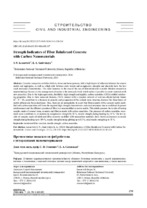| dc.contributor.author | Leonovich, S. N. | |
| dc.contributor.author | Sadovskaya, E. A. | |
| dc.coverage.spatial | Минск | ru |
| dc.date.accessioned | 2024-06-05T11:23:55Z | |
| dc.date.available | 2024-06-05T11:23:55Z | |
| dc.date.issued | 2024 | |
| dc.identifier.citation | Leonovich, S. N. Strength Indicators of Fiber Reinforced Concrete with Carbon Nanomaterials = Прочностные показатели фибробетона с углеродными наноматериалами / S. N. Leonovich, E. A. Sadovskaya // Наука и техника. – 2024. – № 3. – С. 219-224. | ru |
| dc.identifier.uri | https://rep.bntu.by/handle/data/144723 | |
| dc.description.abstract | Concrete composites with low defects, dense and homogeneous, with a high degree of adhesion between the cement matrix and aggregates, as well as a high ratio between static tensile and compressive strengths and plasticity have the best crack resistance characteristics. This ratio increases in the case of the use of fiber-reinforced concrete. Modern research in nanotechnology focuses on the management of matter at the nanoscale level, which makes it possible to create materials with new properties. Due to the high aspect ratio, flexibility, high strength and rigidity, carbon nanotubes (CNTs) exhibit reinforcing properties. Due to their nanoscale features, CNTs interact with a complex network of calcium-silicate-hydrate binder (C – S – H), contribute to a decrease in porosity and compaction of the cement stone structure, increase the shear forces of matrix adhesion in the contact zone. Thus, there are all prerequisites to assert that fiber concrete with a cement matrix modified with carbon nanotubes will have the required high strength characteristics and crack resistance due to multilevel dispersed reinforcement and the efficient operation of fiber in a nanomodified concrete matrix. This article presents the results of testing samples made of cement stone, concrete and fiber concrete with carbon nanotubes. The presence of carbon nanotubes in cement stone contributes to an increase in compressive strength by 11 %, tensile strength during bending by 20 %. The test results of samples made of reinforced fiber concrete modified with nanocarbon materials have shown an increase in tensile strength during bending up to 109 %, tensile strength during splitting up to 82 %, axial tensile strength up to 78 %. | ru |
| dc.language.iso | en | ru |
| dc.publisher | БНТУ | ru |
| dc.title | Strength Indicators of Fiber Reinforced Concrete with Carbon Nanomaterials | ru |
| dc.title.alternative | Прочностные показатели фибробетона с углеродными наноматериалами | ru |
| dc.type | Article | ru |
| dc.identifier.doi | 10.21122/2227-1031-2024-23-3-219-224 | |
| local.description.annotation | Лучшими характеристиками трещиностойкости обладают бетонные композиты с малой дефектностью, плотные и гомогенные, с высокой степенью адгезии между цементной матрицей и заполнителями, а также высоким отношением между статическими прочностями на растяжение и на сжатие и пластичностью. Данное отношение повышается в случае использования фибробетонов. Современные исследования в нанотехнологиях фокусируются на управлении материей на наномасштабном уровне, что позволяет создавать материалы с новыми свойствами. Благодаря высокому соотношению сторон, гибкости, высокой прочности и жесткости углеродные нанотрубки (УНТ) проявляют армирующие свойства. Из-за своих наноразмерных особенностей УНТ взаимодействуют со сложной сеткой кальциево-силикатно-гидратного связующего (C – S – H), способствуют уменьшению пористости и уплотнению структуры цементного камня, увеличению сдвиговых усилий сцепления матрицы в зоне контакта. Таким образом, есть все предпосылки утверждать, что фибробетон с модифицированной углеродными нанотрубками цементной матрицей будет обладать требуемыми высокими прочностными характеристиками и трещиностойкостью за счет многоуровневого дисперсного армирования и эффективной работы фибры в наномодифицированной бетонной матрице. В данной статье представлены результаты испытаний образцов из цементного камня, бетона и фибробетона с углеродными нанотрубками. Наличие углеродных нанотрубок в цементном камне способствует увеличению прочности на сжатие на 11 %, на растяжение при изгибе на 20 %. Результаты испытаний образцов из дисперсно-армированного бетона, модифицированного наноуглеродным материалом, показали прирост прочности: на растяжение при изгибе – до 109 %, на растяжение при раскалывании – до 82 %, на осевое растяжение – до 78 %. | ru |

